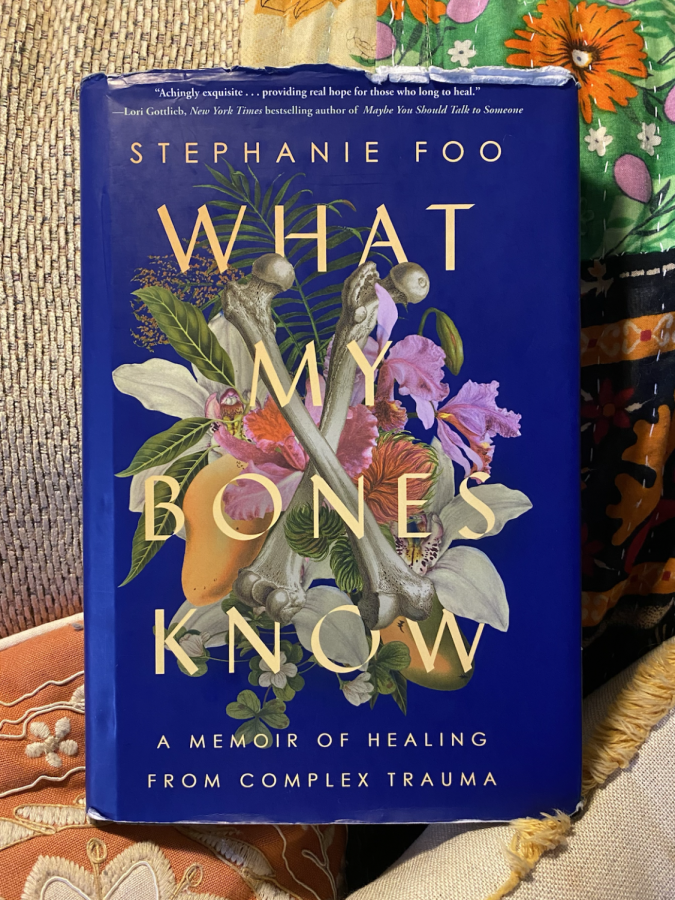Book Review: “What My Bones Know”
What My Bones Know offers a unique look into the life of someone dealing with the after effects of abuse, providing research into c-PTSD itself, and also portraying the thoughts and feelings that makeup a c-PTSD person’s mind.
What My Bones Know: A Memoir of Healing From Complex Trauma offers a beautiful glimpse into Stephenie Foo’s mental space and journey through finding herself, as a young woman dealing with c-PTSD. For those who don’t know, c-PTSD is a specific type of Post Traumatic Stress Disorder that develops when a person is repeatedly exposed to a stressful situation, not just once. She starts off her story with a stunning and colorful book cover that induces a slightly overwhelming feeling in the viewer, perfectly portraying her main emotions throughout the memoir. With overlapping images of human bones, vegetation, and fruits, the cover represents the depth of Foo’s c-PTSDand how it’s embedded in her heritage and DNA. This hints at the subject of epigenetics mentioned throughout the novel, the study of how behavior and genetic code can be impacted by your environment.
What My Bones Know offers a unique look into the life of someone dealing with the after effects of abuse, providing research into c-PTSD itself, and also portraying the thoughts and feelings that makeup a c-PTSD person’s mind. The main form the memoir takes is unfiltered internal dialogue that allows the reader to enter Foo’s mind, understanding how she views the world and how her abuse altered her physical and emotional well being. “I’d always fantasized about indulging in a nervous breakdown. I watched Girl, Interrupted with a twisted, jealous fervor, felt envy when I saw celebrities enter rehab. What entitlement. What privilege, to just let life fall to the wayside, to stop working and pretending to just fall apart.”
She also utilizes humor to acknowledge a coping mechanism that she uses to keep her trauma at bay. “There was a psychiatrist who tried to put me on Prozac. I quoted Brave New World. ‘I want to know what passion is! I want to feel something strongly!’ The psychiatrist responded, ‘I think that passion might be a chemical imbalance.’” Foo hyper-analyzes each of her noticeable mannerisms, trying to understand herself in a desperate attempt to fix herself. The astonishing aspect of this quest is how aware Foo is of her symptoms, acknowledging when she acts as a c-PTSD person is expected to.
The memoir progresses through her stages of realization. The beginning first describes her experience with childhood abuse and how it shaped her psyche. Foo acts like an outside source, not speaking in third person, but viewing her life like a scientist, reflecting and analyzing why and how her life occurred as it did. The pressure Foo puts on herself to become a ‘normal’ functioning member of society becomes clear as her story builds. Emphasis is put on the aspect of fixing oneself and how the stress and anxiety to get your life together can form even worse habits than those stemming from c-PTSD.
What most stood out to me was how honest and transparent Foo seems to be. She refrains from concealing important personal information that made her story easier to understand and empathize with. “I wrung my body out like a towel, twisting both ends with red fists and sinking my teeth into it, gritting it out, ‘It’s fine it’s fine it’s fine,’ until one day, I woke up and there would be a new accolade on my shelf, a new accomplishment I could never dreamed of, and then–finally–it would be fine. It’d be perfect. For that day. Or that hour. And then tendrils of the dread started peeking into the corners of my vision. And I had to start all over again.”
Personal growth is most certainly a repetitive theme in the memoir; Foo develops from a scared and lost young girl into a secure and emotionally intelligent woman, but still leaving her story on a note of unpredictability. She explains how even though many things are explainable, sometimes things just happen and you have to deal with them.
This memoir was a refreshing read; so many fiction books about experiences with childhood abuse victimize their main characters in a helpless way while also romanticizing their harrowing experiences, destroying any chance that hope could have to restore their storyline. Although it may be unfair to compare the two since Foo’s account was real, her point of view highlights the strength that going through abuse takes, empowering herself and others who have dealt with the same thing, revolutionizing past authorial takes on childhood abuse.
Foo’s literary talent is clearly shown through the way she demonstrates her inner sentiments. “The more I read, the more every aspect of my personality is reduced to deep diagnostic flaws. I hadn’t understood how far the disease had spread. How complete its takeover of my identity was. The things I want. The things I love. The way I speak. My passions, my fears, my zits, my eating habits, the amount of whiskey I drink, the way I listen, and the things I see. Everything–everything, all of it—is infected. My trauma is literally pumping through my blood, driving every decision in my brain.” This excerpt speaks to me with an amplified voice, it describes the hellacious and dissociating nature that a diagnosis can have on someone, consuming their identity and replacing it with the alien personality of the affliction. Foo begs the questions: Where do you draw the line between yourself and your c-PTSD? Where do you start and where does your trauma end? Then offers a sensitizing and thought-provoking response.












